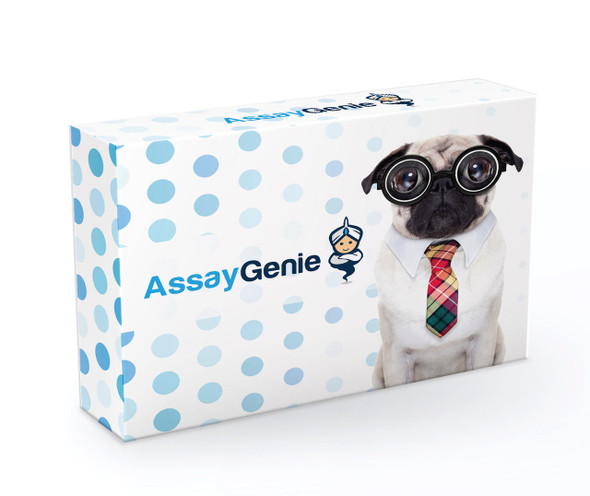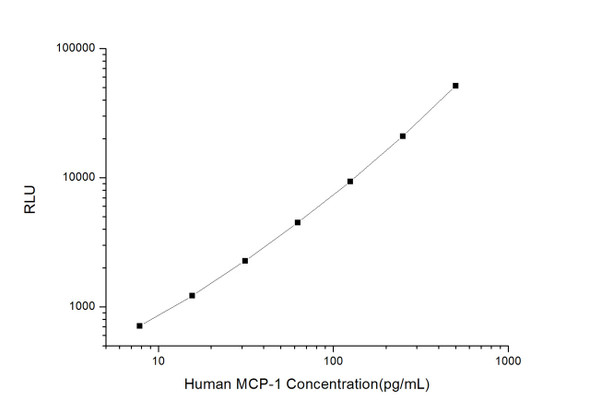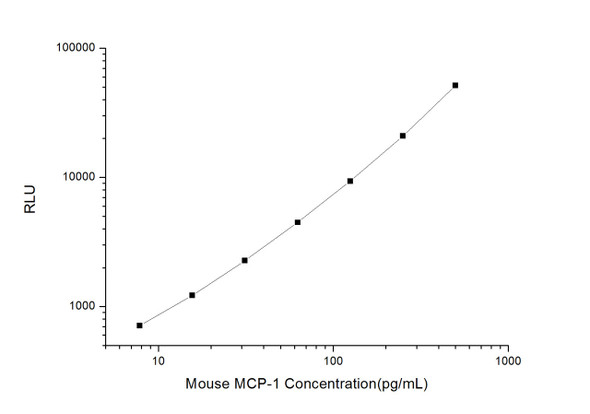Rat Signaling ELISA Kits 3
Rat MCP-1 (Monocyte Chemotactic Protein 1) CLIA Kit (RTES00392)
- SKU:
- RTES00392
- Product Type:
- ELISA Kit
- ELISA Type:
- CLIA Kit
- Size:
- 96 Assays
- Sensitivity:
- 18.75pg/mL
- Range:
- 31.25-2000pg/mL
- ELISA Type:
- Sandwich
- Synonyms:
- CCL2, GDCF-2, HC11, HSMCR30, MCAF, MCP1, SCYA2, SMC-CF
- Reactivity:
- Rat
- Sample Type:
- Serum, plasma and other biological fluids
- Research Area:
- Cell Biology
Description
| Assay type: | Sandwich |
| Format: | 96T |
| Assay time: | 4.5h |
| Reactivity: | Rat |
| Detection method: | Chemiluminescence |
| Detection range: | 31.25-2000 pg/mL |
| Sensitivity: | 18.75 pg/mL |
| Sample volume: | 100µL |
| Sample type: | Serum, plasma and other biological fluids |
| Repeatability: | CV < 15% |
| Specificity: | This kit recognizes Rat MCP-1 in samples. No significant cross-reactivity or interference between Rat MCP-1 and analogues was observed. |
This kit uses Sandwich-CLIA as the method. The micro CLIA plate provided in this kit has been pre-coated with an antibody specific to Rat MCP-1. Standards or samples are added to the appropriate micro CLIA plate wells and combined with the specific antibody. Then a biotinylated detection antibody specific for Rat MCP-1 and Avidin-Horseradish Peroxidase (HRP) conjugate are added to each micro plate well successively and incubated. Free components are washed away. The substrate solution is added to each well. Only those wells that contain Rat MCP-1, biotinylated detection antibody and Avidin-HRP conjugate will appear fluorescence. The Relative light unit (RLU) value is measured spectrophotometrically by the Chemiluminescence immunoassay analyzer. The RLU value is positively associated with the concentration of Rat MCP-1. The concentration of Rat MCP-1 in the samples can be calculated by comparing the RLU of the samples to the standard curve.
| UniProt Protein Function: | CCL13: Chemotactic factor that attracts monocytes, lymphocytes, basophils and eosinophils, but not neutrophils. Signals through CCR2B and CCR3 receptors. Plays a role in the accumulation of leukocytes at both sides of allergic and non-allergic inflammation. May be involved in the recruitment of monocytes into the arterial wall during the disease process of atherosclerosis. May play a role in the monocyte attraction in tissues chronically exposed to exogenous pathogens. By IL1/interleukin-1 and TNF. Widely expressed. Found in small intestine, thymus, colon, lung, trachea, stomach and lymph node. Low levels seen in the pulmonary artery smooth muscle cells. Belongs to the intercrine beta (chemokine CC) family. |
| UniProt Protein Details: | Protein type:Secreted, signal peptide; Secreted; Motility/polarity/chemotaxis; Chemokine Cellular Component: extracellular space; rough endoplasmic reticulum; cell soma; perinuclear region of cytoplasm; endocytic vesicle; cytoplasm; dendrite; extracellular region; synapse; perikaryon; nerve terminal Molecular Function:heparin binding; G-protein-coupled receptor binding; chemokine activity; CCR2 chemokine receptor binding Biological Process: positive regulation of cell adhesion; maternal process involved in pregnancy; positive regulation of leukocyte migration; response to glucocorticoid stimulus; response to lipopolysaccharide; response to antibiotic; monocyte chemotaxis; regulation of cell shape; transforming growth factor beta receptor signaling pathway; response to vitamin B3; negative regulation of neuron apoptosis; response to drug; neutrophil chemotaxis; organ regeneration; response to amino acid stimulus; positive regulation of tumor necrosis factor production; response to ethanol; cellular response to insulin stimulus; response to bacterium; response to heat; response to mechanical stimulus; positive regulation of endothelial cell proliferation; response to activity; response to progesterone stimulus; positive regulation of nitric-oxide synthase biosynthetic process; positive regulation of collagen biosynthetic process; chemokinesis; positive regulation of synaptic transmission; positive regulation of cellular extravasation; positive regulation of cell-cell adhesion; protein kinase B signaling cascade; response to wounding; lipopolysaccharide-mediated signaling pathway; response to gamma radiation; inflammatory response; lymphocyte chemotaxis; aging; cytokine and chemokine mediated signaling pathway; MAPKKK cascade; cytoskeleton organization and biogenesis; glial cell migration; macrophage chemotaxis; leukocyte migration during inflammatory response; cellular calcium ion homeostasis; positive regulation of leukocyte mediated cytotoxicity; negative regulation of angiogenesis; maternal process involved in parturition; response to hypoxia; positive regulation of T cell activation; vascular endothelial growth factor receptor signaling pathway; astrocyte cell migration |
| NCBI Summary: | a monocyte chemoattractant protein [RGD, Feb 2006] |
| UniProt Code: | P14844 |
| NCBI GenInfo Identifier: | 126846 |
| NCBI Gene ID: | 24770 |
| NCBI Accession: | P14844. 1 |
| UniProt Secondary Accession: | P14844,Q549R5, |
| UniProt Related Accession: | P14844 |
| Molecular Weight: | 16,460 Da |
| NCBI Full Name: | C-C motif chemokine 2 |
| NCBI Synonym Full Names: | chemokine (C-C motif) ligand 2 |
| NCBI Official Symbol: | Ccl2 |
| NCBI Official Synonym Symbols: | MCP-1; Scya2; Sigje |
| NCBI Protein Information: | C-C motif chemokine 2; small inducible gene JE; small inducible cytokine A2; small-inducible cytokine A2; monocyte chemotactic protein 1; monocyte chemoattractant protein 1; monocyte chemoattractant protein-1; immediate-early serum-responsive JE protein; immediate-early serum-responsive protein JE |
| UniProt Protein Name: | C-C motif chemokine 2 |
| UniProt Synonym Protein Names: | Immediate-early serum-responsive protein JE; Monocyte chemoattractant protein 1; Monocyte chemotactic protein 1; MCP-1; Small-inducible cytokine A2 |
| Protein Family: | C-C motif chemokine |
| UniProt Gene Name: | Ccl2 |
| UniProt Entry Name: | CCL2_RAT |
As the RLU values of the standard curve may vary according to the conditions of the actual assay performance (e. g. operator, pipetting technique, washing technique or temperature effects), the operator should establish a standard curve for each test. Typical standard curve and data is provided below for reference only.
| Concentration (pg/mL) | RLU | Average | Corrected |
| 2000 | 53498 57944 | 55721 | 55693 |
| 1000 | 22039 25909 | 23974 | 23946 |
| 500 | 11694 10370 | 11032 | 11004 |
| 250 | 5202 5386 | 5294 | 5266 |
| 125 | 2633 2583 | 2608 | 2580 |
| 62.5 | 1409 1213 | 1311 | 1283 |
| 31.25 | 674 674 | 674 | 646 |
| 0 | 28 28 | 28 | -- |
Precision
Intra-assay Precision (Precision within an assay): 3 samples with low, mid range and high level Rat MCP-1 were tested 20 times on one plate, respectively.
Inter-assay Precision (Precision between assays): 3 samples with low, mid range and high level Rat MCP-1 were tested on 3 different plates, 20 replicates in each plate.
| Intra-assay Precision | Inter-assay Precision | |||||
| Sample | 1 | 2 | 3 | 1 | 2 | 3 |
| n | 20 | 20 | 20 | 20 | 20 | 20 |
| Mean (pg/mL) | 99.17 | 177.62 | 990.85 | 96.95 | 186.68 | 909.39 |
| Standard deviation | 10.89 | 16.63 | 64.80 | 9.03 | 13.63 | 63.48 |
| C V (%) | 10.98 | 9.36 | 6.54 | 9.31 | 7.30 | 6.98 |
Recovery
The recovery of Rat MCP-1 spiked at three different levels in samples throughout the range of the assay was evaluated in various matrices.
| Sample Type | Range (%) | Average Recovery (%) |
| Serum (n=5) | 97-112 | 103 |
| EDTA plasma (n=5) | 96-112 | 103 |
| Cell culture media (n=5) | 91-106 | 97 |
Linearity
Samples were spiked with high concentrations of Rat MCP-1 and diluted with Reference Standard & Sample Diluent to produce samples with values within the range of the assay.
| Serum (n=5) | EDTA plasma (n=5) | Cell culture media (n=5) | ||
| 1:2 | Range (%) | 88-101 | 101-116 | 85-99 |
| Average (%) | 94 | 107 | 91 | |
| 1:4 | Range (%) | 87-101 | 89-104 | 94-105 |
| Average (%) | 93 | 96 | 99 | |
| 1:8 | Range (%) | 99-115 | 91-103 | 96-111 |
| Average (%) | 107 | 97 | 102 | |
| 1:16 | Range (%) | 92-106 | 102-114 | 95-110 |
| Average (%) | 98 | 108 | 101 |
An unopened kit can be stored at 4°C for 1 month. If the kit is not used within 1 month, store the items separately according to the following conditions once the kit is received.
| Item | Specifications | Storage |
| Micro CLIA Plate(Dismountable) | 8 wells ×12 strips | -20°C, 6 months |
| Reference Standard | 2 vials | |
| Concentrated Biotinylated Detection Ab (100×) | 1 vial, 120 µL | |
| Concentrated HRP Conjugate (100×) | 1 vial, 120 µL | -20°C(shading light), 6 months |
| Reference Standard & Sample Diluent | 1 vial, 20 mL | 4°C, 6 months |
| Biotinylated Detection Ab Diluent | 1 vial, 14 mL | |
| HRP Conjugate Diluent | 1 vial, 14 mL | |
| Concentrated Wash Buffer (25×) | 1 vial, 30 mL | |
| Substrate Reagent A | 1 vial, 5 mL | 4°C (shading light) |
| Substrate Reagent B | 1 vial, 5 mL | 4°C (shading light) |
| Plate Sealer | 5 pieces | |
| Product Description | 1 copy | |
| Certificate of Analysis | 1 copy |
- Set standard, test sample and control (zero) wells on the pre-coated plate and record theirpositions. It is recommended to measure each standard and sample in duplicate. Note: addall solutions to the bottom of the plate wells while avoiding contact with the well walls. Ensuresolutions do not foam when adding to the wells.
- Aliquot 100µl of standard solutions into the standard wells.
- Add 100µl of Sample / Standard dilution buffer into the control (zero) well.
- Add 100µl of properly diluted sample (serum, plasma, tissue homogenates and otherbiological fluids. ) into test sample wells.
- Cover the plate with the sealer provided in the kit and incubate for 90 min at 37°C.
- Aspirate the liquid from each well, do not wash. Immediately add 100µL of BiotinylatedDetection Ab working solution to each well. Cover the plate with a plate seal and gently mix. Incubate for 1 hour at 37°C.
- Aspirate or decant the solution from the plate and add 350µL of wash buffer to each welland incubate for 1-2 minutes at room temperature. Aspirate the solution from each well andclap the plate on absorbent filter paper to dry. Repeat this process 3 times. Note: a microplatewasher can be used in this step and other wash steps.
- Add 100µL of HRP Conjugate working solution to each well. Cover with a plate seal andincubate for 30 min at 37°C.
- Aspirate or decant the solution from each well. Repeat the wash process for five times asconducted in step 7.
- Add 100µL of Substrate mixture solution to each well. Cover with a new plate seal andincubate for no more than 5 min at 37°C. Protect the plate from light.
- Determine the RLU value of each well immediately.






